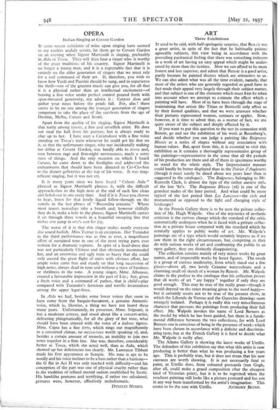ART
Three Exhibitions IT used to be said, with half-apologetic surprise, that Renoir was a great artist, in spite of the fact that he habitually painted agreeable subjects, this view being in accordance with the prevailing puritanical feeling that there was something indecent in a work of art having an easy appeal which might be under- stood by more than the initiate. Now we can afford to be more honest and less superior, and admit that Renoir is a good artist, partly because he painted themes which are atttractive to us.
We can also admit what was all the time evident, namely, that most of the artists who are generally regarded as goOd have in fact made their appeal very largely through their subject matter, and that subject is one of the elements which must first be taken into account when we attempt to estimate the effect which a painting will have. Most of us have been through the stage of maintaining that artists like Titian or Botticelli only affect us by their formal qualities, and that we were unaware whether their pictures represented women, centaurs or apples. Now, however, it is time to admit that, as a matter of fact, we are quite aware of the subject and deeply affected by it.
If you want to put this question to the test in connexion with Renoir, go and see the exhibition of his work at Rosenberg's, and decide whether you can judge a painting like Baigneuse Bless& as a series of shapes without any association with human values. But, apart from this, it is essential to visit this exhibition as it contains a thoroughly representative group of his paintings—representative in the sense that all the periods of his production are there and all of them in specimens worthy to stand for the whole style. The Impressionist manner could hardly be better displayed than in the Poirier d'Angleterre (though it must surely be dated about ten yeari later than is suggested in the catalogue). The Baigneusc, belonging to Mr. Kenneth Clark, is almost the type of the rather austere style of the late '8o's. The Baigneuse Blessee (16) is one of the grandest nudes of the later period. And what could be more typical of the last period than Les Laveuses—the rich and monumental as opposed to the light and changing style of landscape?
At the French Gallery there is to be seen the priVate collec- tion of Mr. Hugh Walpole. One of the Mysteries of aesthetic criticism is the curious change which the standard of the critic automatically undergoes when he is faced with a private collec- tion in a private house compared with the standard which he normally applies to public works of art. Mr. Walpok's paintings are of a type which would certainly impress us if we saw them in the right circumstances, -brit, competing as they do with serious works of art and confronting the public in an open gallery, they are distinctly disappointing.
The collection consists mainly of very minor works by great names, and of respectable works by lesser figures. The result is a group of curious mediocrity, from which stand out a few pieces—above all, two lovely Cezanne watercolours and a charming small oil sketch of a woman by Renoir. Mr. Walpole claims in the preface to the catalogue that his collection proves that all works of art " are happy " together if only they are good enough. This may be true of the really great—though it would depend on the exact meaning given to the word happy— but it certainly seems not to be true of the present show, in which the Liberale da Verona and the Guercino drawings seem strangely isolated. Perhaps it is really this very miscellaneous character that prevents the paintings from producing their full effect. Mr. Walpole invokes the name of Lord Berners as the model by which he has been guided, but there is a funda- mental difference between the two collections, for with Lord Berners one is conscious of being in the presence of work; which have been chosen in accordance with a definite and discrimin- ating taste, but at the French Gallery it is hard to decide what Mr. Walpole is really after.
The Adams Gallery is showing the latest works of Utrillo. The defenders of this exhibition say that what this artist is now producing is better than what he was producing a few years ago. This is probably true, but it does not mean that his new canvases are worth showing. It is not necessarily fatal to paint, as Utrillo does, from coloured postcards (van Gogh, after all, could make a grand composition after the cheapest kind of Victorian print), but it is to be regretted when the resultant painting still looks like a picture postcard and has not in any way been transformed by the artist's imagination. This seems to be the case with Utrillo. ANTHONY BLUNT.














































 Previous page
Previous page